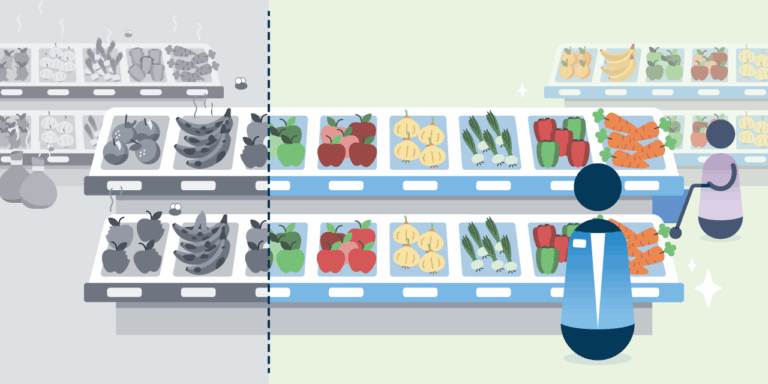Navigating tariff-driven supply chain disruptions
May 22, 2025 • 8 min
Recent tariff changes have disrupted retailers’ and DIY home goods companies’ global sourcing and fulfillment strategies. These changes, layered on top of existing supply chain vulnerabilities, require more than incremental adjustments—they demand a coordinated, technology-enabled transformation of how companies manage inventory, fulfilment, manufacturing, procurement, and risk.
From our perspective as a supply chain software provider for retail, CPG, and manufacturing companies, we believe the most practical and impactful response lies in a three-pronged strategy, addressing:
- Supply Side: Planning with complex optimizations & rapid tradeoffs
- Demand Side: Precision planning with price/margin preservation
- Modular Risk Management: Having an adaptable, integrated business plan
While some of our customers may have spent years building sophisticated enterprise-wide risk management systems, most retail and consumer product firms are finding themselves in a position to rapidly respond to these tariff-related business changes with focused task forces to close gaps and modernize critical workflows to ensure business continuity and successful operational execution.
Background and context
Tariffs have long shaped global trade flows and corporate supply chain decisions. From trade wars to protectionist policies, companies have had to develop flexible, cost-effective, and often creative strategies to maintain business continuity and protect margins.
Here are some examples and strategic responses companies have taken to manage the effects of tariffs on their supply chains from 2016 to 2020.
1. Supply chain diversification
Companies have diversified their manufacturing and sourcing operations to reduce dependence on any single country and improve resilience against trade disruptions.
Examples:
- Williams-Sonoma: In response to the 2019 U.S.-China tariff escalation, Williams-Sonoma cut its China sourcing by 50%, shifting production to countries like Vietnam and Mexico to minimize tariff exposure and stabilize costs.
- Ralph Lauren: The fashion retailer expanded its supplier base to include countries such as Vietnam, Cambodia, and Italy. This helped reduce reliance on Chinese goods and created a more agile supply network.
Impact: These efforts helped companies better control landed costs, reduce risk concentration, and remain competitive in the face of rising tariffs.
2. Tariff avoidance product engineering
This approach involves slightly modifying products to classify them under different Harmonized Tariff Schedule (HTS) codes with lower duty rates. While entirely legal, it requires close collaboration between a company’s engineering, legal, and supply chain teams.
Examples:
- Columbia Sportswear: By adding “nurse pockets” to certain women’s shirts, Columbia qualified for a lower import duty classification, significantly reducing costs without compromising the product’s functionality.
- Converse: Converse added felt soles to its Chuck Taylor All-Stars to reclassify them as “slippers,” which are taxed at a lower rate than standard sneakers. This creative classification saved the company substantial duty fees on large volumes of imports.
Impact: Tariff engineering has allowed companies to legally reduce tax burdens through minor design adjustments, improving profitability.
3. Production relocation
In several instances, companies have responded to tariff increases by moving manufacturing operations to countries not subject to the new tariffs or closer to end markets.
Examples:
- LG Electronics: Faced with U.S. tariffs on washing machines, LG opened a U.S. factory in Tennessee in 2018. The domestic facility allowed them to circumvent the import duties and continue serving the U.S. market competitively.
- Ford Motor Company: To avoid the 25% tariff on imported light trucks, Ford imported Transit Connect vans from Turkey as passenger vehicles. Once in the U.S., they removed the rear seats to convert them into cargo vans. Although controversial and eventually challenged, this tactic avoided millions in tariffs.
Impact: Relocation mitigates tariff exposure but requires significant capital and time. It’s often a medium-to-long-term solution that companies with high exposure or large production volumes employ.
4. Friendshoring
A newer trend, friendshoring, refers to shifting sourcing and production to politically allied countries that are more stable and aligned with the importing country’s trade policies.
Strategic Insight:
- Companies increasingly seek supply chain partners in geopolitically aligned nations to reduce trade risks and ensure more stable access to goods.
- For example, U.S. manufacturers have begun reshoring to Mexico and Central America, not only to avoid geopolitical tensions with China but also to gain proximity advantages and reduce lead times.
Impact: Friendshoring has become a favored strategy for companies balancing cost, reliability, and geopolitical considerations. However, this time, the varied and widespread nature of the tariff structures makes friendshoring a bit more challenging.
History shows successful companies treat tariffs not as isolated disruptions but as catalysts to re-engineer their supply chains for agility and resilience. Strategies such as supplier diversification, tariff engineering, production relocation, and friendshoring allow businesses to stay adaptive in a world where trade policies are increasingly dynamic. These historical lessons offer valuable guidance for companies today facing a new wave of tariff structures.
Strategies for managing supply chains with the realities of tariffs in 2025
1. Supply side: Planning with complex optimizations and rapid tradeoffs
Rebuild inventory strategy for agility
The shift from Just-in-Time (JIT) to more resilient inventory models. Prioritize building higher safety stocks for high-margin, fast-turning products. Use specialized optimization models for lead time variability, tariff exposure, and other costing parameters.
Supply optimization with tariff-aware logic
Incorporate tariff structures into sourcing and purchasing decisions, enabling supplier selection based not just on unit cost and capability but also on tariff-induced landed costs.
For example, companies can reconfigure their sourcing networks by pulling volume out of heavily tariffed regions like China into Mexico and Southeast Asia, or use certain suppliers to serve specific markets, such as the UK versus the USA, or make an optimization between prebuy vs stick with a status quo supply plan.
Near real-time inventory decisions
A near real-time view of inventory across the network allows for more dynamic interfacility moves in response to supply shocks or tariff policy changes. This allows for accurately replenishing inventory to the right locations based on need and projections of spoilage and enforces FIFO logic.
2. Demand side: Precision planning with price/margin preservation
Refined S&OP with profitability and supply constraint lens
Traditional S&OP processes must now account for tariff-driven constraints. Use analytics to distinguish between base and marginal demand and focus fulfillment on the most strategic and profitable SKUs and customers.
Don’t try to serve every customer or every order—serve what matters most to your business. This is a fundamental shift in S&OP processes where companies will be forced to reckon with a supply constraint planning environment, much like the days of the COVID pandemic.
Companies must make complex trade-offs, including product substitutions, recipe changes, and sourcing location changes. Lead times and transportation capacity are expected to change quite a bit, and networks will undergo dynamic changes. Managing all this complexity requires the application of sophisticated algorithms.
Assortment replanning and dynamic SKU management
Frequent and intelligent assortment changes are now key; teams need tools to simulate product substitutions and bundling variations and assess the impact on margin and customer service. Further, planners should be able to run scenarios with complex tradeoffs that include product substitutions, recipe changes, and sourcing location changes, using AI/ML-driven tools to model product phase-ins and phase-outs and improve forecast accuracy.
Dynamic pricing models for tariff pass-through
Companies should revisit their pricing infrastructure and embed tariff awareness into pricing engines. Just as during the COVID inflation spikes, firms should adopt rules-based and AI-enhanced forecasting models to assess and make decisions based on pricing’s impact on demand.
3. Risk management: Modular approach with an adaptable integrated business plan
Creating a monolithic risk management platform from scratch will take years. Instead, we recommend implementing modular solutions empowered to act quickly in critical areas:
Adaptable integrated business plan
Now more than ever, companies need a flexible and scalable platform combining short-term tactical and longer-term strategic planning. Tools and processes must be “always on” and support quick decision-making as required, along with AI-driven automation for efficiency and precision.
Assortment replanning and product onboarding
Planning teams must operate more like agile software teams, be able to run multiple scenarios, and have user-enabled adaptability for business and process changes. They must also ensure clear business value, which can be measured by implementing KPI/performance dashboards that monitor OTIF, tariff-adjusted margin, and product substitution behaviors.
Self-service capability for business users for dynamic reconfiguration
Organizations must empower business users with “configure, not code” capability to cope with fast-evolving supply chains and trade policies. They must also enable exception-driven, touchless planning to maximize planner productivity and efficiency. AI (both specialized and generative AI) will enable all this, providing actionable insights to supplement human intelligence.
4. Purchase planning: Smarter sourcing, faster onboarding
Finally, smarter sourcing and rapid supplier onboarding will be key strategic tactics that companies must adopt. However, in this domain, RELEX does not provide specific solutions; our customers can leverage the RELEX partner network to address these specific topics.
Review and enforce contractual protections
Businesses should re-audit supplier agreements for clauses on cost pass-through, currency fluctuation, lead times, and captive capacity rights. Implementing AI-enabled contract intelligence platforms helps flag non-compliance and identify automation opportunities to enforce these contract policies.
Rapid supplier switching and onboarding
Given the likely high turnover of suppliers due to tariff optimization, onboarding workflows must be streamlined. This includes integrating vendor management systems (VMS) with automated risk screening, financial scoring, and real-time tariff flagging, significantly reducing time to onboard new dropship vendors within days.
Customer case study
RELEX helped a leading player in the coconut-based beverage industry effectively manage tariff-related supply chain adjustments and reconfigurations. The customer has a global supply chain spanning 15 factories (and growing) and 20+ market warehouses on several continents, and RELEX helped level the production across the network.
Supply chain complexity came from a global supplier network (Southeast Asia, India, South America) and a global customer base (US, Europe, UK), tariff differences between countries, tough capacity constraints, supplier commitments, and the need for load optimization across different container sizes.
The solution consisted of accurately representing this supply chain network of 100+ SKUs, 15+ Factories, 250+ SKU warehouses, SKU factories, 127 Ocean Freight-Port Pairs, and tariff structures within the RELEX platform.
The ability to represent this level of detail was essential to allow dynamic reconfiguration of supply networks from one region’s suppliers to another, to ensure that these minimum supplier capacity commitments were respected. The ability to represent the tariff structures within the RELEX solution meant that these tariff structures were included in the optimization algorithms as a key input and not as an afterthought calculation on a spreadsheet. Also, the customer was able to run multiple scenarios with configurable business rules to explore several “what-ifs” and the rapidly changing business environment
Recommendations & next steps
Dealing with tariff disruptions is not just about making the supply chain more resilient—it’s about making it more intelligent. Companies that can act fast, harness technology, and empower agile cross-functional teams will emerge with stronger margin control and customer loyalty.
We recommend the following next steps:
- Inventory Optimization Pilot: Launch a proof-of-concept for total landed cost-aware fulfillment planning.
- Tariff-Aware Pricing Engine: Retrofit existing pricing tools to include real-time tariff data feeds.
- Near Real-Time Inventory Optimization: Implement an inventory visibility and optimization solution to reduce stockouts and, more importantly, wastage for perishable goods.
- Dynamic Scenario Planning: Rapidly use low-code platforms to configure and reconfigure business rules and scenarios.
- Risk Task Force Program Office: Create a PMO with clear metrics and ownership for the four task forces outlined above.



